
King Amanullah and Queen Soraya of Afghanistan on their European tour in 1928. Private Collection.
Part 3, on the evolution of Afghanistan’s moderate cultural heritage laws, the export of antiquities from 1958 until 1980, and how a law imposed by its Communist puppet government led to a death sentence for a British Museum curator.
First Archaeological Agreements in Afghanistan
Afghanistan was never colonized by any Western power, defeating three British incursions over the 19th and early 20th centuries and numerous attempts by Iranian and Russian rulers to influence its political development. Afghanistan’s emirs did not welcome foreign archaeologists or other academics until the modernizing reign of Amanullah Khan (1919-1929).
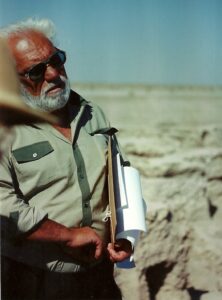
Victor Sarianidi, archaeologist of the Afghanistan Bronze Age, Gonur Tepe, Turkmenistan, 1990s.
Amanullah created the first Museums Department, which contracted exclusively with French archaeologists, establishing the Delegation Archaeologique Francaise en Afghanistan (DAFA). DAFA archaeologists concentrated on excavations of Hellenistic and Kushan period sites. French domination of Afghanistan archaeology meant that there was relatively little work on Afghanistan’s rich prehistoric, Bronze Age, and Islamic period sites until the 1960s.
In the 1960s and 1970s, American, Soviet, Japanese and other international archaeologists were also granted permission to excavate, broadening the scope of archaeological work. (See CPN’s brief summary, Afghanistan’s 4000 Years of Cross-Border Empires and Trade.)
An Institute of Archeology was established in Kabul in 1966, and Afghan archaeologists, many with advanced training from foreign universities, partnered with foreign experts, including Americans Louis and Nancy Dupree at prehistoric excavations and Soviet archaeologist Victor Sarianidi, who was the primary archaeologist and discoverer of the Bronze Age civilization known as the Bactria–Margiana Archaeological Complex (BMAC), but who is also famous for uncovering the Tilla Tepe hoard, one of the richest treasures of ancient worked gold and silver ever found. After a Soviet-directed revolution in Afghanistan in 1978, Western archaeologists were expelled and Sarianidi refused to continue his work there.
Afghanistan’s Modern Law on Cultural Heritage

Commemorative Stamp, Afghanistan, Souvenir Sheet, Issued on 1969-01-02, Series Archaeological Treasures (Bagram era), Wikimedia Commons.
Afghanistan’s 1958 law on cultural heritage is the Code for the Protection of Antiquities in Afghanistan. This moderate national law stated in Clause 3 that “All antiquities, whether movable or immovable, unearthed or buried underground, are part of national antiquities and under the protection and surveillance of the State. No one can possess or claim possession of these antiquities except in accordance with the condition laid down in this Code.”
Clause 5 stated that “The power to determine the artistic value of antiquities is vested in the Directorate-General of Museums and Preservation of Antiquities in Afghanistan.” The Directorate was allowed to take all parts of ancient structures already removed from monuments or mosques and place them in the Museum in Kabul.
The 1958 law allowed the State to acquire antiquities from private owners on payment of a fair price and dealers in antiquities were licensed. The Directorate was tasked with carrying out an inventory of immovable antiquities, which then remained the property of the owner, who had continuing responsibility to protect it, not to damage it or build on it or bury the dead there. Persons owning antiquities were called upon to declare them so they may be inventoried. Failure to declare a found object was punished, but finders who declare objects are supposed to be rewarded.
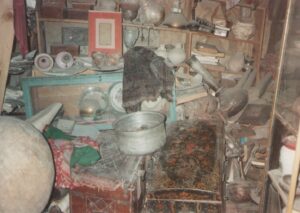
Kabul, Afghanistan 1970s, Rajab Ali’s antique shop on Chicken Street.
The 1958 Law gave the right of excavation for the purpose of discovering, acquiring and studying antiquities solely to the Government of Afghanistan. A Department established for that purpose could delegate the right to excavate on “a temporary basis to scientific organizations through permission granted on the basis of an agreement for archaeological excavations.” Each excavation by a foreign team had to be accompanied by an engineer, an artist or photographer, an epigrapher (except for prehistoric period excavations) and several representatives of the Directorate-General of Museums. Farmers had to be compensated for the loss of use of their lands, which were supposed to be restored by the archaeological teams at the end of the season.
Clause 54 of the 1958 law indirectly addressed the subject of partage, stating that “Distribution of antique articles unearthed during excavations shall take place in accordance with the terms of the agreement concluded with the excavating delegation.”
Key clauses of the 1958 law governed the export of antiquities. Clauses 59-61 prohibited the export of antique articles without the written permission of the Directorate-General of Museums and Preservation of Antiquities in Afghanistan. This written permission could be obtained by writing to the Directorate -General and sending a description and the price paid together with the name, address, profession and nationality of the exporter (or in practice, by taking the object to the museum and having the archaeologist/specialist there describe it, as the export permit had to be written in Afghan Dari for the Customs).
The Open Market in Afghanistan Art and Antiquities
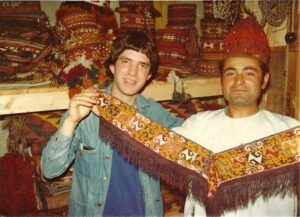
Ghulam Siddiq’s shop selling 20th C tentbands, Uzbek embroideries. Circa 1974.
Archaeological excavations led by both Afghan and foreign scholars existed contemporaneously with a legal market for many antiquities and quasi-legal market for others. The Kabul museum granted export permits on certain antiquities and virtually all ethnographic material (except Nuristan wooden sculpture) until at least 1982. Many antiquities flowed out of Afghanistan in the 1960s and 1970s, both through the museum permitting system and in the hands of tourists when large number of young travelers (and quite a few older ones) came to Afghanistan for the first time and it became known as “the friendliest country in the world, possibly the universe.”
Afghanistan held an enormous backlog of accidental finds of ancient beads, seals and minor artifacts of bronze and stucco and especially of Islamic ceramics and metalwork, which was never buried.[1] The major Afghan dealers in Kabul, all located within a few blocks of the Interior Ministry, were licensed and operated largely unencumbered by restrictions. They were prohibited from selling Buddhist or Hellenistic material or major artworks from other periods. (Clause 68 of the 1958 law gave the Directorate-General the right to purchase antiquities on equal terms with other bidders. Clause 72 gave the Directorate-General the right to inspect licensed shops and inventory lists, and the right to take photographs and mold-impressions.)
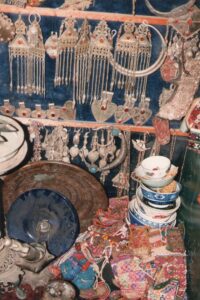
Contemporary embroideries, Turkoman jewelry, and metalware including 12th c lampstand in Kabul shop.
A wide range of low-quality to middling-important antiquities were displayed in the licensed dealers’ shop-front windows or in funky, glass fronted cabinets inside the fancier stores, sometimes stacked in dusty, hodge-podge piles along with Islamic manuscripts and calligraphy samples, old backgammon boards, and European knickknacks. In a small park at the end of the Shar-i-Naw (New City)’s only arterial, several dozen dealers too poor to open shops displayed antiquities and handicrafts on cloths laid on the ground. The Kabul shop-owners wouldn’t pay cash for goods unless they were top quality, so the traders would set up temporary shop in the park to sell as much as they could on their own.
Members of the Kabul Museum staff and foreign archeologists such as Victor Sarianidi and Louis Dupree frequented all of the dealer shops and open air stands in the park to see what had turned up. At the time, the collectors with the most money were primarily diplomats and aid workers.
With respect to the trade in Afghanistan coins, we refer readers to the expert analysis and commentary by Peter Tompa in Coins of Afghanistan – Documenting History and Trade, Cultural Property News, September 5, 2021.
Briefly, much of the 1970s coin trade in Kabul took place near the Hamidi family-owned supermarket in Shar-i-Naw; coincidentally, Hakim Hamidi, the deputy director of the Da Afghanistan Bank, was one of the most important coin collectors, a popular hobby among the Kabul intelligentsia.
Exporting Antiquities Legally Before the Soviet Invasion

Kabul Afghanistan 1970s, Rajab Ali’s antique shop.
There was legal export of a wide variety of objects from antique metalwork to ancient beads during the 1950s, 1960s and 1970s. Before the Soviet invasion, the Afghan artifact-vetting system worked in a way that could have served as a model for reasonable source-country export policy. Its failings were related more to inefficiency and the lack of government interest in setting up a fee system that could have provided revenue to support museum or archeological activities by allowing more expensive items to be exported at higher fees.
The required review of all items (except costume, textile and carpets) for export took place at the museum in Darulaman. A knowledgeable archaeologist/specialist would describe the materials brought to him and either refuse or grant permission for export. There was a very small fee, and items (jewelry, ceramics, wood, metalwork) were stamped with ink and listed on an invoice in Persian for the customs to check at export. Anything with any age had to pass this scrutiny. The museum experts did not take bribes, nor did they seize objects (until the academic staff were replaced with communists in the 1980s). Many minor materials, especially Islamic ceramics or metalwork, could receive export permits.
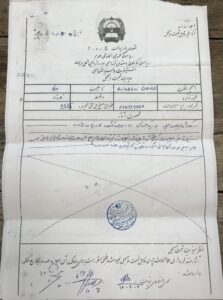
Export permit issued by the National Museum, Kabul.
After the Soviet invasion, to this author’s specific knowledge, at least one archaeologist at the museum took the position that it was better for objects to go to the West than be “looted by the Russians,” as he said.
The vast majority of ethnographic art and antiquities from Afghanistan will not have retained these permits for export or the inked markings with which they were stamped. They were only required for Afghanistan customs and were not considered documentation for commercial entry to the United States as they were written in Persian. There could be 50 or more items described on a single export document. If such paperwork was once associated with specific objects, it is likely to have been discarded over the last 25/50/75 years.
(It was well-known that Gandharan stone and clay materials were not allowed export. These were transported illegally to Pakistan, sometimes said to be smuggled at the bottom of a truckload of fruit or through the bus service, but the details are not known. Once in Pakistan, corruption was rife and objects could leave the country in a variety of ways.)
Law Under the Soviet-Puppet Regime and the Arrest of British Scholar Ralph Pinder-Wilson
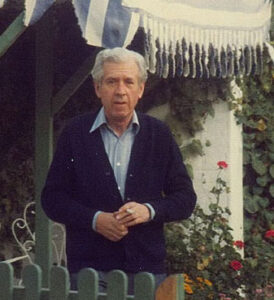
Ralph Pinder-Wilson, Director of the British Institute of Afghan Studies in Kabul and Deputy Keeper in the Department of Oriental Antiquities of the British Museum. Ancient India and Iran Trust photo.
A Soviet-backed communist coup in 1978 led to the establishment of a series of puppet governments. American Ambassador Adolph Dubs was murdered in February 1979, supposedly in a botched rescue attempt after a kidnapping. The US cut relations with Afghanistan. In 1980, one year after the December 1979 Soviet invasion, a new cultural heritage law (La loi sur la protection des biens historiques et culturels 1980) was instituted by the Soviet puppet government. It stated that any manmade thing with “an outstanding historical, scientific or cultural value” belonged to the State. Licensed dealers could buy antiquities but not sell them to foreigners. Like many other laws instituted at this time, it was never enforced, even in Kabul.[2] There was no mechanism for enforcement of many ‘reformist’ and ‘modernizing’ laws issued at this time or the will to enforce them. By 1982, the Afghan countryside was held by various mujahideen groups and the ruling party, the Marxist People’s Democratic Party of Afghanistan (PDPA), had only a tenuous hold even in major cities, and not even on all of Kabul.
The only person known to have been prosecuted under the new 1980 law was Ralph Pinder-Wilson, retired Deputy Keeper of Islamic Art at the British Museum and head of the British Institute in Afghanistan. In March 1982, he was detained for possessing Afghan cultural property: the archaeological artifacts from the British Institute’s excavations in Kandahar. These had been transported from Kandahar with the permission and assistance of the Afghan government and Pinder-Wilson was on his way to the Ministry of Interior to arrange for their storage when he was arrested.
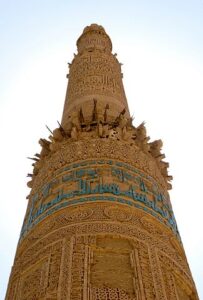
Minaret of Jam, Harirud, Afghanistan, Photo by David Adamec, 2006, public domain.
Pinder-Wilson did not have diplomatic status. Consular access was denied to him and official protests ignored. There was international outrage. Some weeks later he was charged with illegally exporting Kushan coins and with spying. In June 1982 he was brought before the Revolutionary Council Court and sentenced to be executed, though this was soon reduced to ten years’ imprisonment. Just a few weeks later, he was abruptly released and flown to Delhi.
By almost any standards, Afghanistan never enforced the 1980 cultural heritage law except to make this one, false accusation against an elderly British scholar. This leaves open the question of whether the 1980 law was given effect, since the museum continued to issue export permits to foreigners as well as to Afghans until at least 1982. The legal status of objects that left Afghanistan at various times between 1980 and 2004 remains unclear.
The Exodus of Millions of Afghans
As Afghans left the country and travel became more difficult, the antiquities, antiques and ethnographic markets moved to Pakistan, together with millions of Afghan refugees. In Peshawar, people from the Afghan countryside and people from the cities came into more frequent contact with each other than ever before. New alliances and business arrangements were forged among refugees. A number of young, highly intelligent Afghans educated themselves about ancient art and became international dealers, cornering much of the best material that came to market in Pakistan, taking it directly to buyers in Europe, Japan and the United States. These young Afghan dealers were well known to the Afghan and Pakistan governments, but tolerated.
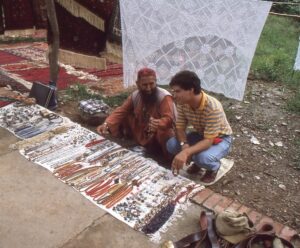
Islamabad, Pakistan park market for Afghanistan beads and oddments.
Before the war, although halting grave robbing was not a national priority, there had been local power structures that would either respond quickly to quash illicit digging in most areas or seize artifacts for themselves. There was, however, no functional mechanism for rewarding farmers for turning in chance finds as required under the 1958 law – on the contrary, accidental finders would often be accused of holding back items and beaten. Professional artifact hunting was not common, because it was much harder work than farming. Outside of Buddhist religious edifices, most artifacts were located in scattered graves or emergency caches left from times of war. Finds were almost entirely accidental, although a rich accidental discovery could prompt speculative digging in the same region.
During the war looting became a survival mechanism for people who were entirely without other resources. Before the war, over 90% of the people in Afghanistan had been involved in direct food production. During the war, an estimated 7 million people out of a total population of 14 million left the country, because non-combatant Afghan farmers and their families were directly targeted by the Soviets in a scorched earth policy, hoping that without food or places to hide, the insurgency would fail. It was a war waged against civilians – and far more terrible that most Westerners could even imagine. A million dead, the majority of them women and children, hundreds of thousands maimed and crippled – the numbers are staggering. People did anything and everything they could to survive.
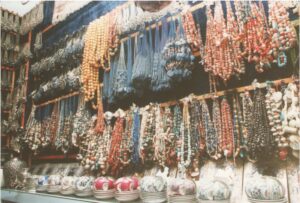
Peshawar, Pakistan, Afghan shop with ancient, ethnographic, and copies of ancient beads, Russian tea services.
The notion of a massive, organized criminal trade in Afghanistan antiquities in the war-time situation of free-fall anarchy is ludicrous, especially given that during the war there was an explosion in poppy production on both sides of the Afghanistan/Pakistan border. With the curtailing of heroin production in the Golden Triangle, chemists came to Pakistan’s Tribal Territory and Pakistani military and government officials made partnerships with mujahedeen and other power brokers there. Pure powder heroin was sold on the street in Peshawar and Islamabad and offered as a matter of course to foreigners by taxi drivers for $10 a gram. This created a far more lucrative criminal market than antiquities or any other commonly-smuggled goods, for example, highly taxed foreign electronics and appliances, and it was far easier to transport. Some smuggling of antiquities continued. In the later war years and during the first Taliban takeover, Afghan “warlords” certainly took advantage of connections with Pakistani military and high level government officials to occasionally move important antiquities to Europe or Japan. However, there was so much more money in military equipment and materiel, drugs, illegal mineral extraction and general corruption that antiquities – which were awkward to transport, fragile, and hard to sell – hardly rated the attention of people in power, who in any case, lacked the specialized knowledge needed to trade in them.

Begram, Afghanistan, Decorative plaque from a chair or throne, ivory c. 100 BCE, © National Museum of Afghanistan and Trustees of the British Museum.
It was a time when scholars, archaeologists, and American and European art dealers – unable and unwilling to trade in objects stolen from the Kabul museum, watched the markets anxiously, hoping to see these irreplaceable objects appear and fearing that when they did, they would be damaged and uncared for. Part of this story has been published, with names redacted to protect the guilty.[3]
Law Under the American-backed Kabul Regime
In 2004, the Government of Afghanistan adopted a new constitution and issued a new cultural heritage law voiding the 1980 law. Permits were required for export and only licensed sale was allowed. Private ownership and collecting was allowed for Afghan citizens but the State could buy antiquities preemptively from them. In 2005, Afghanistan signed the 1970 UNESCO Convention. In these two steps, Afghanistan’s government brought its law in line with other relatively liberal national heritage laws. What the future will be in a country essentially without laws, in which the law of the day is based upon the Taliban’s peculiar interpretation of Sharia combined with Pashtun customary law – is unknown.
This is Part 3 of a 4 part series.
Part One Afghanistan’s Heritage: A Former Government, the Taliban, and a Questionable Blockade
Part Three The Evolution of Afghanistan’s Cultural Heritage Law: How Communists Turned a Workable Law Against Archaeologists and Sentenced a British
Museum Curator to Death
Part Four Afghanistan’s 4000 Years of Cross-Border Empires and Trade
[1] It was not uncommon to see objects cobbled together from different periods still in use, such as a 19th c iron brazier with a 12th c engraved bronze tray stuck in the bottom when the original tray wore out, or 8th-15th c ceramics jumbled together on shelves with Meissen porcelain in Kabul’s antique shops.
[2] A blizzard of new regulations, from land reform to orders to paint all doors in Kabul red, were likewise ignored or deliberately violated. The ‘red door’ law prompted immediate repainting of many doors, but in an Islamic green instead.
[3] See, for example, the tale of the Begram ivories, eventually rescued by English dealer John Eskenazi and returned to the Kabul Museum. “Johnny Eskenazi on the cultural casualties of the Afghan war: An evening with Kalashnikovs and the Begram ivories,” The Art Newspaper, December 31, 2001, https://www.theartnewspaper.com/2002/01/01/johnny-eskenazi-on-the-cultural-casualties-of-the-afghan-war-an-evening-with-kalashnikovs-and-the-begram-ivories
 Postage stamp, Afghanistan, featuring Shahr e Zohak, the Bamiyan valley and Band i Amir., 1965.
Postage stamp, Afghanistan, featuring Shahr e Zohak, the Bamiyan valley and Band i Amir., 1965. 

